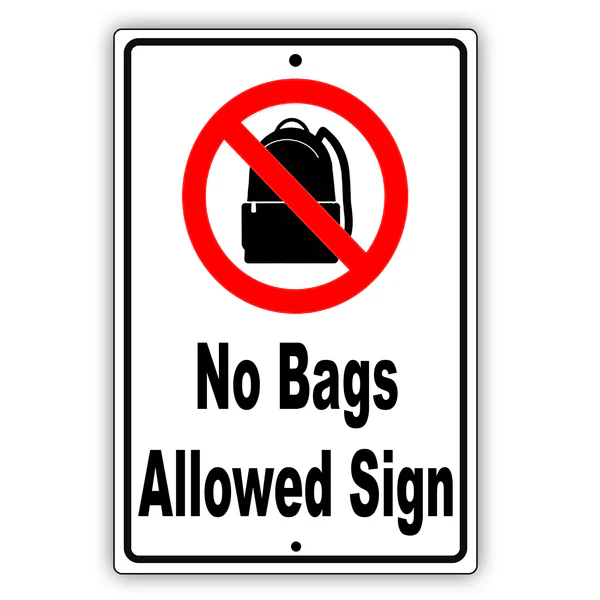No Bags Allowed Signs: Enhancing Security, Safety, and Efficiency in Public Spaces

In our increasingly security-conscious world, the importance of clear communication in public and private spaces has never been greater. One common and highly effective tool used across venues, businesses, and institutions is the “No Bags Allowed” sign. These signs convey a simple but crucial message: carrying bags into certain areas is prohibited.
From concert venues to exam halls and retail shops, No Bags Allowed signs are a vital part of ensuring safety, preventing theft, and maintaining smooth operations. In this article, we’ll explore the significance of these signs, where they are typically used, the reasons behind bag restrictions, and how to effectively implement them in your space.
What Does a “No Bags Allowed” Sign Mean?
A “No Bags Allowed” sign clearly indicates that individuals are not permitted to enter a specific area while carrying any kind of bag. This can include:
- Backpacks
- Handbags
- Tote bags
- Laptop bags
- Sports bags
- Shopping bags
Depending on the location and policy, this may apply to all bags, or only to larger-sized or unapproved bags. These signs are typically posted at entrances and checkpoints to provide advance notice to guests or customers.
Why Are No Bags Policies Important?
There are several reasons why businesses and institutions implement no-bag policies, each driven by concerns for security, efficiency, and safety.
1. Security and Anti-Theft Measures
No bags policies are commonly enforced in:
- Retail environments (to reduce the risk of shoplifting)
- Concerts, stadiums, and large public gatherings (to prevent individuals from carrying weapons or contraband)
- Museums and galleries (to avoid accidental damage or theft of valuable exhibits)
By eliminating bags from the premises, businesses reduce the potential for theft, smuggling, or vandalism.
2. Streamlined Security Checks
In venues with large crowds—such as airports, sports arenas, and festivals—checking bags at entry points can significantly slow down the screening process. Prohibiting bags allows for faster security lines, improving the overall experience for attendees and minimizing staffing needs.
3. Safety in Sensitive Areas
In places like examination halls, bags can be associated with cheating, distractions, or unauthorized materials. Prohibiting bags helps maintain the integrity of exams and ensures a focused, equal environment for all candidates.
Similarly, labs and cleanrooms may prohibit bags to prevent contamination or fire hazards, enhancing safety and cleanliness.
4. Space Optimization
In small venues, classrooms, or historical sites, large bags may obstruct walkways or create tripping hazards. Limiting bag access ensures that the environment remains safe and accessible for everyone.
Common Places Where “No Bags Allowed” Signs Are Used
- Retail stores and shopping centers
- Cinemas and theaters
- Museums and art galleries
- Examination centers
- Schools and colleges
- Event venues, stadiums, and festivals
- Airports and transportation hubs
- Government buildings and courthouses
- Religious or sacred spaces
In some cases, alternative arrangements such as bag checks or lockers may be provided.
Design Tips for Effective No Bags Allowed Signs
To ensure that your No Bags Allowed sign is clear and respected, consider the following design elements:
- Bold, Readable Fonts: Use clear, large lettering to ensure the message is easy to read from a distance.
- Universal Symbols: Include an image of a bag with a red circle and line through it for instant recognition.
- Bilingual or Multilingual Text: In multicultural or international areas, include translations to accommodate non-English speakers.
- Placement: Install signs at entrances, gates, checkpoints, and any decision points where individuals may still turn back.
- Durability: Choose materials such as metal, plastic, or laminated vinyl for long-lasting, weather-resistant signage.
Examples of helpful text:
- “No Bags Allowed Beyond This Point”
- “Due to Security Protocols, Bags Are Not Permitted Inside”
- “Please Leave Bags in the Locker Area Provided”
Enforcing No Bags Policies
Posting a sign is only part of the solution—proper enforcement ensures that your policy is respected. Here are some best practices:
- Train Staff: Make sure your team is aware of the policy and knows how to communicate it clearly and respectfully.
- Offer Alternatives: Provide bag checks, lockers, or transparent bag options if needed.
- Stay Consistent: Enforce the rule consistently to avoid confusion and maintain credibility.
- Handle Exceptions Thoughtfully: Make accommodations for medical bags, diaper bags, or accessibility-related items when necessary.
Legal and Ethical Considerations
While security is important, it’s crucial to respect individuals’ rights and maintain a fair, inclusive policy. Make sure your no-bag policy:
- Is clearly communicated in advance (via website, tickets, signage)
- Applies equally to all individuals
- Includes reasonable exceptions where appropriate
- Does not violate local laws or regulations
Final Thoughts
No Bags Allowed signs are an essential part of modern security and operational strategies. They help protect people, preserve property, and ensure that events and business operations run smoothly. Whether you’re managing a retail store, organizing an event, or safeguarding an educational or cultural institution, these signs serve as a simple but powerful communication tool.
By implementing and enforcing a clear no-bag policy, you demonstrate a commitment to safety, professionalism, and efficiency—making your environment more secure and comfortable for everyone involved.




